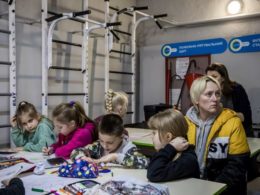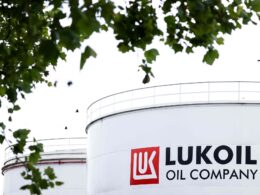Russians abandon Andriivka, important Russia’s logistical hub near Bakhmut. Ukrainian forces continue primary offensive operations in Zaporizhzhia Oblast. NATO condemns Russia’s Black Sea attacks; increases surveillance.
Daily overview — Summary report, July 27
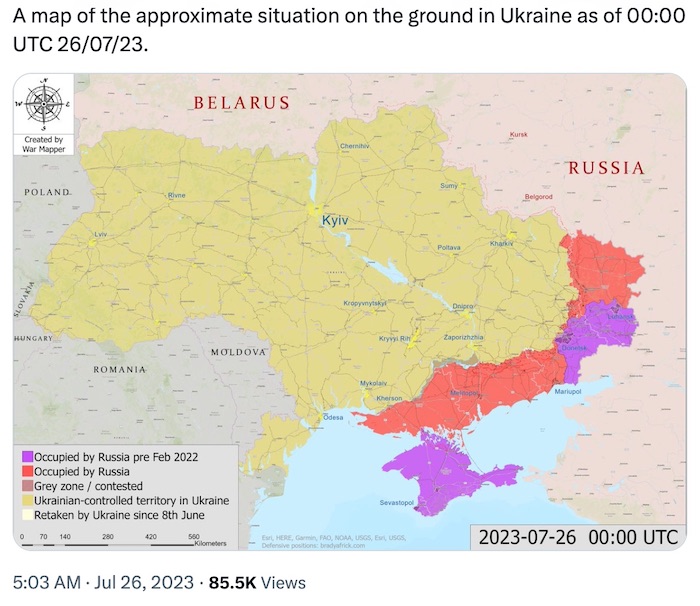
The General Staff’s operational update regarding the Russian invasion as of 18.00 pm, July 27, 2023 is in the dropdown menu below:
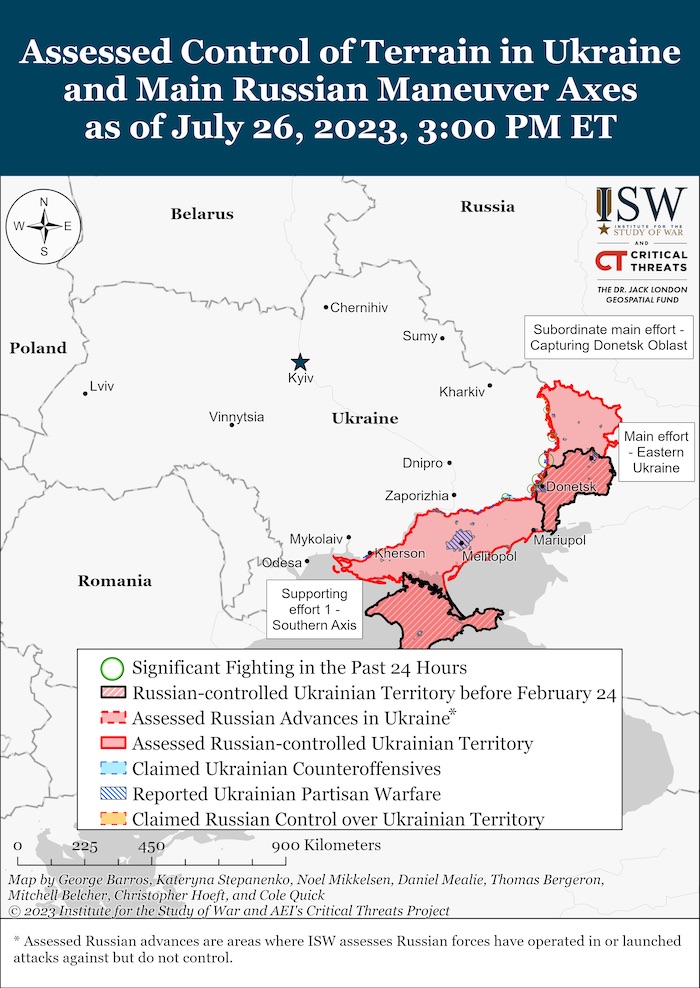
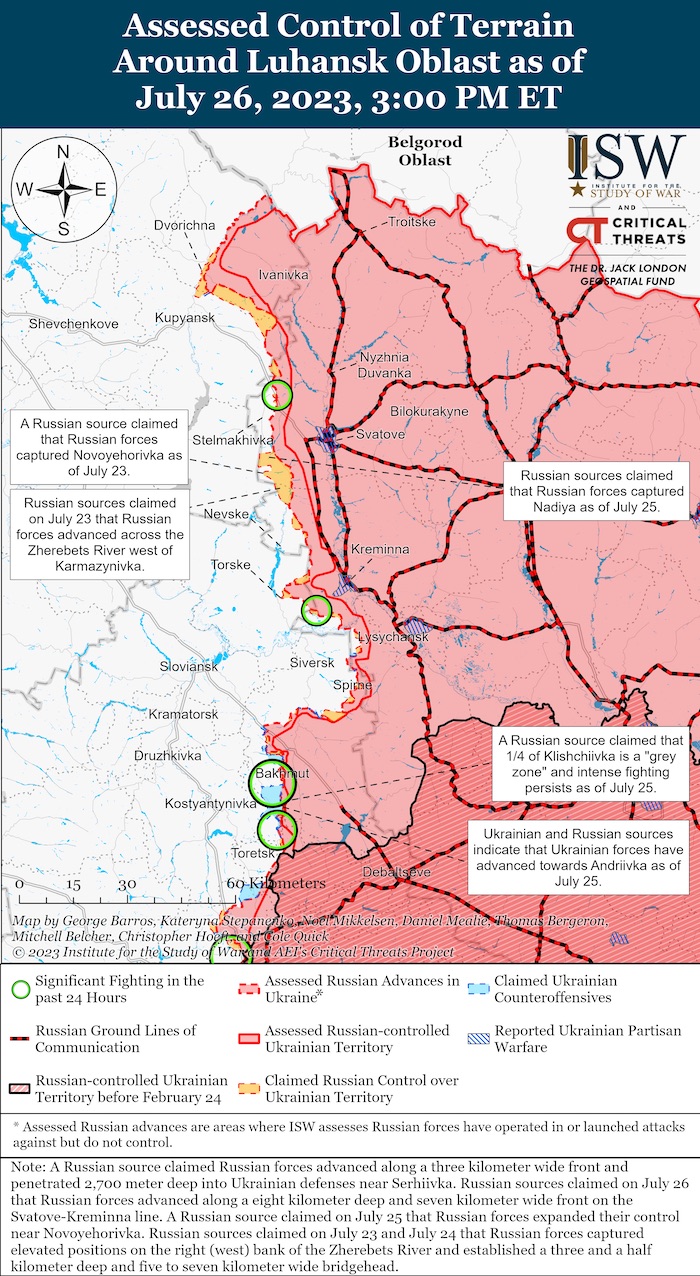
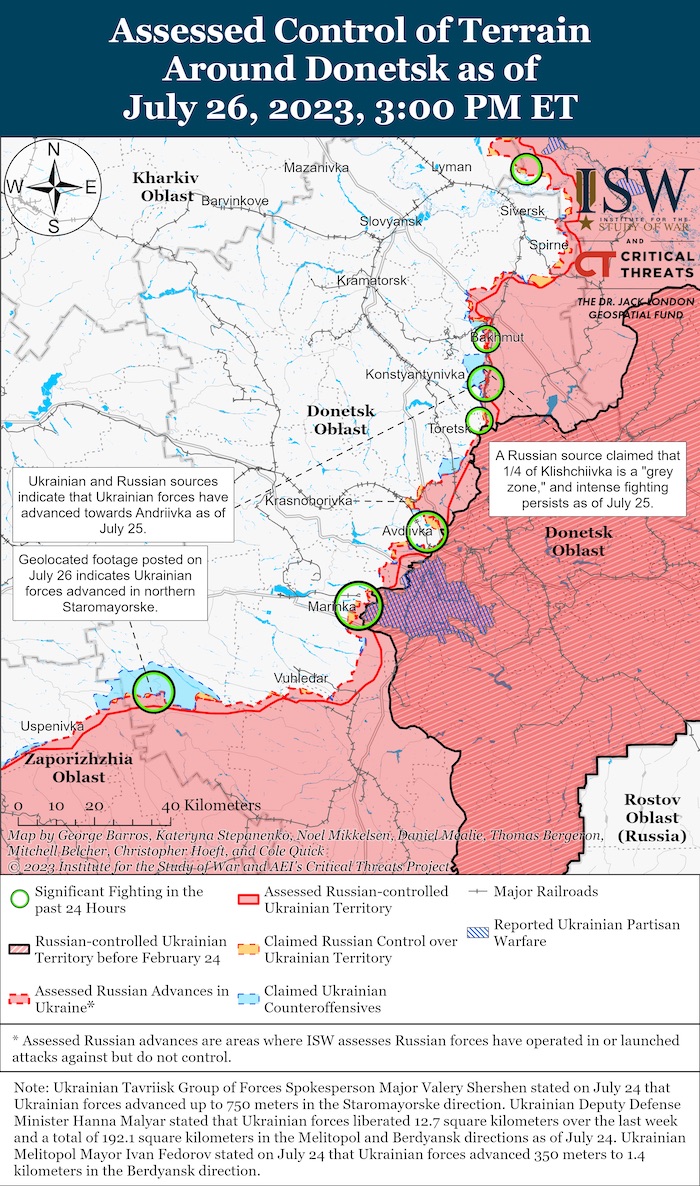

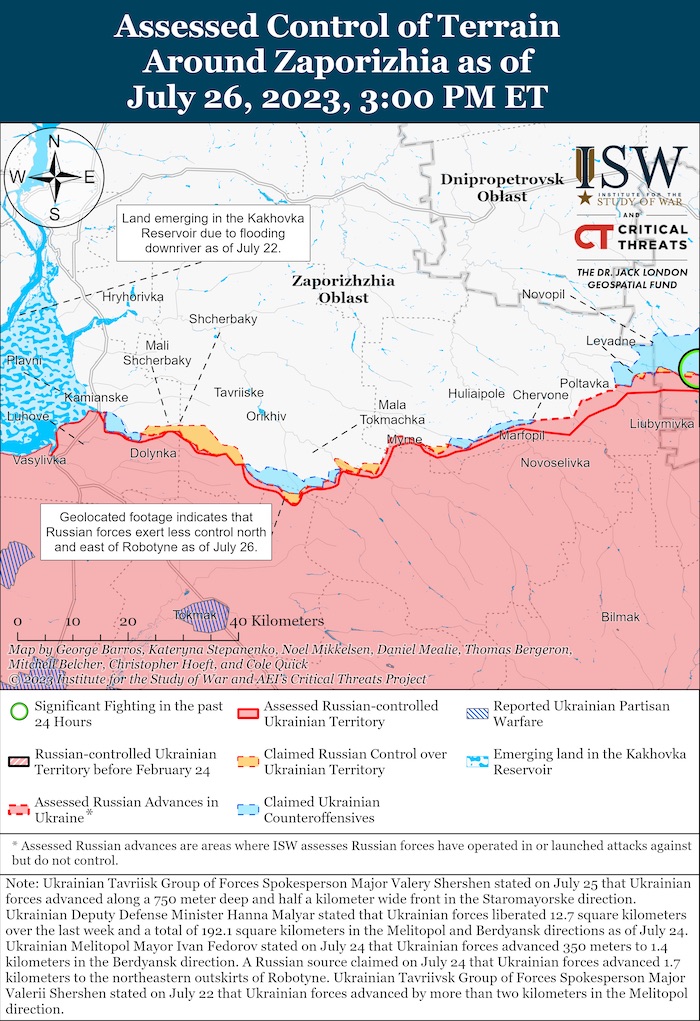

Military Updates
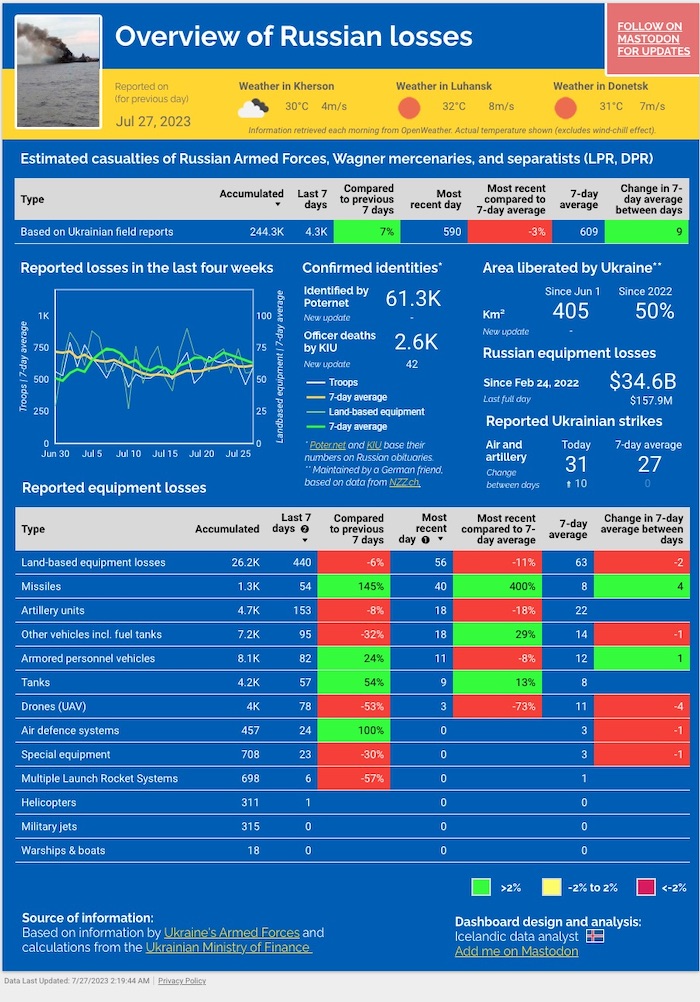
German Bundeswehr slams Ukraine’s use of Western warfare methods. Bundeswehr (The German Armed Forces) criticized the actions of the Ukrainian Armed Forces during the ongoing counteroffensive for not using the Western methods of warfare correctly, according to Bild. The German military cites the separation of combat units as one of the main shortcomings of the Ukrainian Armed Forces, which “makes it impossible” to conduct successful combined arms operations, the Bild reported.
Frontline report: Russians abandon Andriivka, crucial Russia’s logistical hub near Bakhmut. A lot of good news from the East. In recent developments, Ukrainians noticed a significant shift in the allocation of Russian troops. Desperately diverting their forces to Klishchiivka, Russians left their flanks exposed, and the Ukrainians astutely capitalized on this temporary weakness to launch a successful flank attack. This operation proved to be of utmost importance for the Ukrainian forces, as it allowed them to establish a new bridgehead east of the canal and eventually crush the Russian defense. Witnessing the advancing Ukrainians getting closer to Andriivka, Russian forces responded by sending dozens of tanks to clear the tree lines and force the Ukrainian troops to retreat.
According to British Defence Intelligence, (last 48 hours):
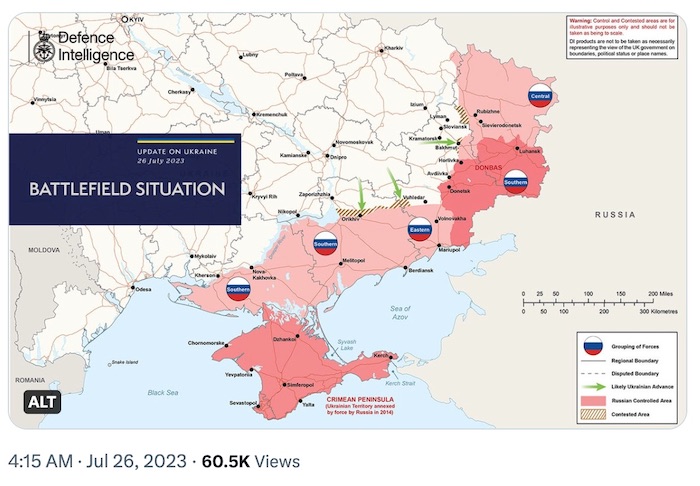
- As Ukrainian forces continue major offensive operations in Zaporizhzhia Oblast, one of the single most influential Russian weapon systems in the sector is the Ka-52 HOKUM attack helicopter. Russia has highly likely lost around forty Ka-52s since the invasion, but the type has also imposed a heavy cost on Ukraine.
- In recent months, Russia has highly likely augmented the force in the south with at least a small number of brand new, Ka-52M variants: a heavily modified aircraft, informed by lessons from Russia’s experience in Syria. Evidence supporting the M variant’s use in Ukraine includes photos posted on social media of aircrew posing next to the new aircraft and thanking well-wishers for sending them morale items.
- Another key improvement to the Ka-52 fleet is the integration of a new anti-tank missile, the LMUR, which has a range of approximately 15km. Ka-52 crews have been quick to exploit opportunities to launch these weapons beyond the range of Ukrainian air defences.
Losses of the Russian army
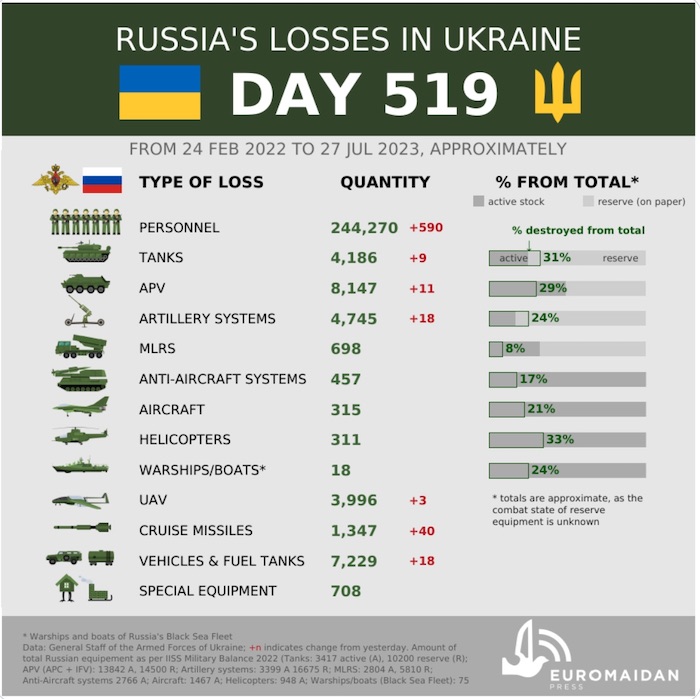
Humanitarian
US Marine veteran, freed from Russia in 2022, injured amidst Ukrainian warfare. Trevor Reed, a former US Marine who participated in a prisoner exchange between the United States and Russia in 2022, was injured while warfighting in Ukraine, AP reports. Trevor Reed was injured several weeks ago, but the circumstances are not specified. According to the US State Department, Reed was flown to Germany for medical treatment by a non-governmental organization.
Trending Now
Russia destroyed 180 schools in Ukraine, over 1,000 educational institutions damaged. Russian forces completely destroyed 180 schools in Ukraine and damaged more than 1,000 educational institutions. “As of today, 180 schools have been destroyed to the ground. Over 300 educational institutions in total are destroyed, more than 1,000 educational institutions are damaged and need to be examined to determine whether they can be rebuilt or not,” Ukrinform reported, citing Ukraine’s Minister of Education and Science Oksen Lisovyi. According to Lisovyi, three-quarters of Ukrainian schools are equipped with shelters of varying levels and quality.
Legal
HIMARS missiles not responsible for killing Ukrainian POWs in Olenivka – UN. There is no evidence that HIMARS missiles were used to strike at a detention center in occupied Olenivka (Donetsk Oblast) almost a year ago when at least 50 Ukrainian prisoners of war were killed, UN Human Rights Chief Volker Türk said on 25 July 2023. Although Russia declined to provide “satisfactory assurances about secure access for the United Nations to visit the particular site” in Russian-occupied Olenivka and refused to grant general requests by the UN Human Rights Office (Office) to access occupied territories of Ukraine, the Office conducted extensive interviews with survivors of the incident at Olenivka and undertaken a detailed analysis of available additional information, Volker Türk stated.
Support
EU ambassadors agree on new sanctions package against Belarus. On Wednesday, 26 July, EU ambassadors agreed on a new set of sanctions against Belarus. The announcement was made by Rikard Jozwiak, the Europe Editor at Radio Free Europe/Radio Liberty, via Twitter. “EU ambassadors have just approved sanctions on Belarus. Mainly aviation and dual-use goods. More important: no derogation for Belarusian potash. But expect this question to come up again in the autumn,” the journalist tweeted.
Foreign donors pledge almost a quarter billion dollars to Ukraine for demining. Ukraine will get more than $244 million for humanitarian demining, Ukraine’s Minister of Economy Yulia Svyrydenko announced. The funds will be allocated by foreign donors, including the government of the United States, the European Union, Japan, Germany, the United Kingdom, Norway, Sweden, Italy, Lithuania, the Netherlands, Denmark, Canada,
New Developments
NATO condemns Russia’s Black Sea mayhem but will only increase surveillance. On 26 July, the NATO-Ukraine Council held its first meeting, during which the Alliance condemned Russia’s unilateral suspension of participation in the Black Sea Grain Initiative and the shelling of Ukrainian port infrastructure. It also said it would ramp up surveillance measures, according to the official NATO portal.
Leader of Wagner in Belarus was born in Ukraine, fought in Chechnya, Syria – media. Journalists from Belarusian media outlet Nasha Niva and the monitoring project All Eyes on Wagner have revealed that the Wagner Group PMC in Belarus is being led by a 46-year-old Ukrainian-born man named Sergey Chubko, who previously fought in Syria and Chechnya. The monitoring group reported that during a gathering at a camp near Osipovichi on 19 July, Wagner’s leader, Yevgeny Prigozhin, referred to the person in charge of the Belarusian direction as “Sergey with the nickname ‘Pioner’.”
Iran aids Russia in drone plant construction, a potential war changer in Ukraine – CNN. Russia, with Iran’s help, is constructing a factory to produce attack drones for use in war in Ukraine. “A new drone stockpile orders of magnitude larger” than what Russia could previously acquire from Iran. Iran helps Russia to build a drone-manufacturing facility in the country that “could have a significant impact on the war in Ukraine once it is completed,” CNN reports. According to US Intelligence, the drone-manufacturing facility now under construction is expected to provide Russia with a new drone stockpile that is “orders of magnitude larger” than what it has been able to procure from Iran to date. The plant in Russia’s Alabuga economic zone (it is an industrial and manufacturing economic zone in the Elabuga district of Tatarstan Republic, Russia) is likely to be ready at the beginning of 2024.
Assessment
- On the war.
The Institute for the Study of War has made the following assessment as of July 26, 2022:
Ukrainian forces launched a significant mechanized counteroffensive operation in western Zaporizhzhia Oblast on July 26 and appear to have broken through certain pre-prepared Russian defensive positions south of Orikhiv. Russian sources, including the Russian Ministry of Defense (MoD) and several prominent milbloggers, claimed that Ukrainian forces launched an intense frontal assault towards Robotyne (10km south of Orikhiv) and broke through Russian defensive positions northeast of the settlement.[1] Geolocated footage indicates that Ukrainian forces likely advanced to within 2.5km directly east of Robotyne during the attack before Russian forces employed standard doctrinal elastic defense tactics and pushed Ukrainian troops back somewhat, although not all the way back to their starting positions.[2]
Russian sources provided a wide range of diverging claims as to the scale of both the attack and resulting Ukrainian losses, indicating that the actual results and Ukrainian losses remain unclear. The Russian MoD claimed that up to three battalions engaged in a “massive assault” near Orikhiv, but ISW has not yet observed visual evidence to suggest that such a large number of personnel (a full brigade) were involved in the attack.[3] One prominent Russian milblogger claimed that Ukrainian forces used over 80 armored vehicles, and other milbloggers more conservatively claimed that the number was closer to between 30 and 40.[4] Various Russian milbloggers additionally made disparate claims about how many armored vehicles Russian forces destroyed.[5] ISW has also not yet observed a large number of heat anomalies from NASA’s FIRMS / VIIRs sensors in this area of the frontline of the sort that have historically accompanied large, mechanized pushes.[6] The disagreement amongst several prominent Russian sources, who have generally tended to offer more mutually consistent claims about the size of and losses resulting from previous Ukrainian attacks, indicates that the situation remains less than clear and that Ukrainian forces may have been more successful than assessed by Russian commentators.
The battlefield geometry around Robotyne, as well as the force composition of the Russian elements defending there, offer important color to speculation surrounding the Ukrainian attack and gains. Geolocated footage from July 27 shows two Ukrainian Bradley infantry fighting vehicles and a T-72 tank either disabled or abandoned about 2.5km due east of Robotyne, which is a point that is about 2.5km south of the current frontline.[7] This geolocated point is beyond the forward-most pre-prepared Russian defensive fortifications in this area, indicating that Ukrainian forces managed to penetrate and drive through tactically challenging defensive positions. This kind of penetration battle will be one of the most difficult things for Ukrainian forces to accomplish in pursuit of deeper penetrations, as ISW has previously assessed. The defensive lines that run further south of Robotyne are likely less well-manned than these forward-most positions, considering that Russian forces have likely had to commit a significant portion of available forces to man the first line of defensive positions that are north and east of Robotyne.
Ukrainians appear to have rotated fresh forces into this area for the operation whereas Russian forces remain pinned to the line apparently without rotation, relief, or significant reinforcement in this sector. Russian milbloggers and unnamed Pentagon officials additionally noted that the Ukrainian units that participated in the July 26 attack are reserves that belong to older and more established Ukrainian brigades.[8] These reports indicate that Ukraine may now be employing fresh and generally more experienced units in the battle, whereas the same Russian 58th Combined Arms Army elements (particularly the 71st Motorized Rifle Regiment of the 42nd Motorized Rifle Division) have been engaged in defensive operations in this very area continually since the beginning of the Ukrainian counteroffensive in early June without relief.[9]The introduction of fresh Ukrainian reserves to the effort, together with the geometry of Russian defensive lines and the likely degraded overall state of Russian forces in this area, may allow Ukraine to begin pursuing more successful advances south of Orikhiv in the coming weeks.
Western and Ukrainian officials suggested that the attacks towards Robotyne mark an inflection in Ukraine’s counteroffensive effort. The New York Times reported on July 27, citing two anonymous Pentagon officials, that the “main thrust” of the Ukrainian counteroffensive has begun in earnest.[10] The Western officials noted that this is an opportune moment for Ukrainian efforts given recent gradual Ukrainian operations to clear Russian defensive positions, Russian command changes following the dismissal of 58th Combined Arms Army Commander Major General Ivan Popov, and continued Ukrainian artillery strikes against Russian concentration areas in southern Ukraine, which are all elements that are consistent with ISW’s assessment on the state of play in southern Ukraine.[11] Ukrainian President Volodymyr Zelensky also cryptically stated in his nightly address on July 27 that Ukrainian forces “had very good results today” and that he will provide more details at a later date.[12]
Today’s actions around Robotyne are likely the start of any “main thrust” Ukrainian forces might be launching, if the US officials are correct, rather than the sum of such a thrust. Even accepting the high estimate of three battalions as the Ukrainian force offered by the Russian MoD, three battalions comprise a single brigade, whereas Ukraine is known still to have in reserve multiple uncommitted brigades readied for the counteroffensive.
Western officials are unhelpfully raising expectations for rapid and dramatic Ukrainian advances that Ukrainian forces are unlikely to be able to meet, as well as offering forecasts of the likely Ukrainian avenues of advance that should probably not have been shared publicly. ISW continues to assess that Ukrainian forces can make significant gains in their counteroffensive operations, but that such gains are likely to occur over a long period of time and interspersed with lulls and periods of slower and more grinding efforts as the Ukrainians come to successive Russian defensive lines and themselves require relief and rotation.
Russian forces conducted a large-scale missile strike largely aimed at rear areas in Ukraine on the night of July 26. The Ukrainian General Staff reported that Russian forces launched 40 missiles, including three Kalibr cruise missiles and four Kh-47 Kinzhal air-launched ballistic missiles.[13] Ukrainian air defenses shot down at least 36 missiles, including all three Kalibr missiles.[14] It is currently unconfirmed if Ukrainian air defenses shot down the four Kinzhals.[15] The Ukrainian Air Force Command reported that missiles were recorded over Kharkiv, Poltava, Kirovohrad, Vinnytsia, Mykolaiv, Odesa, Ternopil, Lviv, Kyiv, Zhytomyr, and Khmelnytskyi Oblasts.[16] Various Russian sources claimed that the strikes hit the Starokostyantyniv Air Base in Khmelnytski Oblast.[17]
The Russian Black Sea Fleet is increasing military posturing in the Black Sea, likely in an attempt to set conditions to forcibly stop and search civilian vessels and exert increased control in the area. The Ukrainian Military Media Center and UK Ministry of Defense (MoD) reported that Russian forces are preparing vessels on the Black Sea to “enforce a blockade on Ukraine.”[18] The Ukrainian Military Media Center reported that the Black Sea Fleet is increasing combat training for its surface forces and naval aviation.[19] The Black Sea Fleet is unlikely to attempt a full blockade of Ukraine despite increased measures against civilian vessels, however. A full Russian blockade of Ukraine in the Black Sea would mean that Russian forces could fire on all vessels attempting to reach Ukraine. Russia is highly unlikely to attempt to enforce such a complete blockade lest it trigger military conflict with Black Sea littoral countries including NATO members Romania, Bulgaria, and Türkiye that the Kremlin has hitherto worked hard to avoid. Current Russian posturing in the Black Sea more likely suggests that Russia is setting conditions to search civilian and commercial vessels while posturing for a blockade as a means of gaining additional leverage. The UK MoD reported that the Russian corvette “Sergei Kotov” is patrolling the shipping lane between the Bosphorus Strait and Odesa Oblast and that the “Sergei Kotov” corvette may be part of a task group to intercept commercial vessels that Russian forces assess are headed to Ukraine.[20] The Russian MoD claimed on July 20 that Russian forces would consider all vessels en route to Ukraine as potential carriers of military cargo.[21] Russian opposition outlet Astra reported on July 24 that the Russian State Security Service (FSB) announced that it searched a foreign cargo ship heading from Türkiye to Rostov-on-Don and denied its passage through the Kerch Strait.[22] The FSB claimed that the ship could be delivering explosives to Ukraine because the ship’s crew included 12 Ukrainian citizens and announced that it would search other vessels crossing Kerch Strait.[23]
The US Department of Defense (DoD) announced on July 26 that it authorized another presidential drawdown to provide an additional $400 million of security assistance to Ukraine.[24] The DoD stated that the package will include ammunition for HIMARS, munitions for Patriot air defense systems and National Advanced Surface-to-Air Missile Systems (NASAMS), and other critical military equipment.[25]
Angry Patriots Club members may be attempting to align their movement to free former Russian officer and prominent ultranationalist milblogger Igor Girkin with outrage at an anti-war sociologist’s arrest in order to appeal to a broader audience. Russian opposition news outlet Meduza reported on July 26 that Russian authorities arrested Director of the Institute of Globalization and Social Movements (which the Russian Ministry of Justice designated as a foreign agent in 2018) and professor at the Moscow School of Social and Economic Sciences Boris Kagarlitsky on charges of “justifying terrorism” in a post on Telegram about the Ukrainian strike on the Kerch Strait Bridge in October 2022.[26] The Angry Patriots Club published a Telegram post expressing solidarity with Kagarlitsky and claiming that both Girkin’s and Kagarlitsky’s arrests were politically motivated.[27] The Angry Patriots acknowledged that Girkin and Kagarlitsky hold different political views but called for the freedom of political prisoners.[28] Girkin’s supporters may be attempting to frame Girkin’s arrest as a fight against political repression in order to galvanize support for Girkin from beyond the narrow confines created by his ultranationalist ideology and difficult personality. ISW continues to assess that the Angry Patriots Club movement is relatively isolated in the Russian ultranationalist information space, and the Angry Patriots Club may be attempting to make Girkin’s arrest more palatable to a general audience in order to increase support for the movement to free him.[29]
Russia continues to find ways to remind Armenia and Azerbaijan that Moscow’s military and diplomatic presence in the South Caucasus is necessary. Russian Foreign Minister Sergei Lavrov, Armenian Foreign Minister Ararat Mirzoyan, and Azerbaijani Foreign Minister Jeyhun Bayramov met in Moscow for bilateral and trilateral negotiations regarding Nagorno-Karabakh on July 25.[30] Lavrov walked a careful balance between mediator and participant during the trilateral negotiations, signaling Russia’s support for various Armenian and Azerbaijani positions while continuing to delay any real discussion of a long-term, effective peace agreement. A Kremlin-affiliated Russian milblogger highlighted that an assistant was caught on a live microphone, likely intentionally, telling Lavrov not to refer to Nagorno Karabakh as the “former Nagorno-Karabakh Autonomous Oblast” because the Azerbaijanis would not appreciate it.[31] The milblogger noted that this was a simple, yet effective manipulation tactic that signaled to Armenia Russia’s desire to please Azerbaijan.[32] Lavrov managed to cater to Armenia as well by stating the importance of “direct dialogue between Stepanakert and Baku” and “guaranteeing the rights and security of the Armenians of Nagorno-Karabakh” supporting Armenian Prime Minister Nikol Pashinyan’s most recent rhetoric about these issues.[33] It is likely Lavrov also secured Azerbaijan’s approval for the Armenian government to send 400 tons of humanitarian aid to the residents of Nagorno Karabakh through Russian peacekeepers during the July 25 trilateral negotiation.[34]
The Russian government may have intended for the Russia-Armenia-Azerbaijan trilateral meeting to reduce possible Iranian efforts to supplant Russian influence with Armenia by providing Shahed drones to Yerevan.[35] Israel-based i24News claimed on July 16 that Armenia has used Iranian Shahed drones in several recent clashes with Azerbaijan.[36] The American Enterprise Institute’s Critical Threats Project previously assessed that Iran may expand its military support to Armenia in response to Russian “negligence” towards the Caucasus.[37] The trilateral meeting may have been an attempt to reassert Russia’s influence over Armenia vis-à-vis Iran, influence that has become particularly fragile following Russia‘s redeployment of elements of its “peacekeeping force” from Nagorno-Karabakh to Ukraine in March 2023.[38]
A prominent Kremlin-linked milblogger expressed his incredulity that the US has not provided Ukraine F-16 fighters yet and did not assess Russian deterrence or escalation cycle dynamics to be a factor. The milblogger expressed surprise at the West’s lack of progress in giving Ukraine F-16s, stating it is “not entirely clear why Washington is dragging its feet.”[39] The milblogger laid out at length several hypotheses and potential explanations for the lack of progress in approving the final policy on giving Ukraine F-16s.[40] The milblogger notably did not include the threat of Russian nuclear escalation or other deterrence factors in his list of hypotheses of why Western policymakers have not yet sent the fighters to Ukraine.[41] ISW continues to assess that the risk of nuclear escalation remains extremely low.[42]
Key Takeaways:
- Ukrainian forces launched a significant mechanized counteroffensive operation in western Zaporizhzhia Oblast on July 26 and appear to have broken through certain pre-prepared Russian defensive positions south of Orikhiv.
- Russian sources provided a wide range of diverging claims as to the scale of both the attack and resulting Ukrainian losses, indicating that the actual results and Ukrainian losses remain unclear.
- The battlefield geometry around Robotyne, as well as the force composition of the Russian elements defending there, offer important color to speculation surrounding the Ukrainian attack and gains.
- Western and Ukrainian officials suggested that the attacks towards Robotyne mark an inflection in Ukraine’s counteroffensive effort. Today’s actions around Robotyne are likely the start of any “main thrust” Ukrainian forces might be launching, if US officials are correct, rather than the sum of such a thrust.
- Russian forces conducted a large-scale missile strike largely aimed at rear areas in Ukraine on the night of July 26.
- The Russian Black Sea Fleet is increasing military posturing in the Black Sea, likely in an attempt to set conditions to forcibly stop and search civilian vessels and exert increased control in the area.
- The US Department of Defense (DoD) announced on July 26 that it authorized another presidential drawdown to provide an additional $400 million of security assistance to Ukraine.
- Russia continues to find ways to remind Armenia and Azerbaijan that Moscow’s military and diplomatic presence in the South Caucasus is necessary. The Russian government may have intended for the Russia-Armenia-Azerbaijan trilateral meeting to reduce possible Iranian efforts to supplant Russian influence with Armenia by providing Shahed drones to Yerevan.
- A prominent Kremlin-linked milblogger expressed his incredulity that the US has not provided Ukraine F-16 fighters yet and did not assess Russian deterrence or escalation cycle dynamics to be a factor.
- Russian forces conducted offensive operations along the Kupiansk-Svatove-Kreminna line, in Bakhmut, along the Avdiivka-Donetsk City line, in western Donetsk Oblast, and in western Zaporzhia Oblast on July 26 and have made advances in certain areas.
- Ukrainian forces continued counteroffensive operations along at least three sectors of the front on July 26 and have advanced in certain areas.
- Ukrainian military sources reported that Russian forces have begun using Russian-produced Shahed drones against Ukraine.
- Russian occupation authorities continue to pursue infrastructure projects in occupied areas to facilitate the economic integration of occupied Ukraine into the Russian system.


